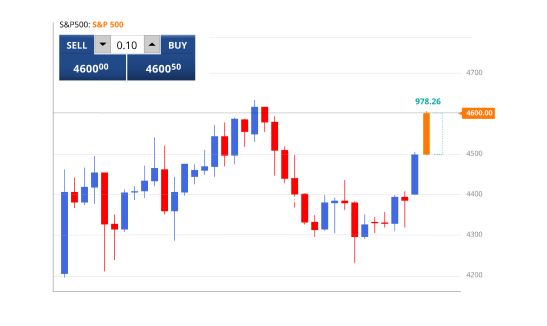交易指数差价合约
交易美国、英国、欧洲、亚洲和澳大利亚的指数
交易有风险
指数来自
US, 英国、欧盟和亚洲
贸易来源
$0 佣金
直到
1: 100 杠杆
+
16 指数
指数来自
US, 英国、欧盟和亚洲
贸易来源
$0 佣金
直到
1: 100 杠杆
+
16 指数
交易全球股票市场指数
符号
出价
问
点差

*本页价格仅供参考。流动性较低的工具,如但不限于外来货币对、股票和指数,其价格不像一般交易工具那样经常更新。请查看您的MT4/MT5平台内的最新实时价格
什么是指数?
指数是按行业或国家/地区组织的股票集合,可跟踪其总体表现。指数对于监控更广泛的股票市场总体表现特别有用。同时,它还提供了一种单一的可交易工具,可让您投资于所有指数成分股。

热门指数包括
S&P 500
Symbol: S&P500
由美国500家大公司组成的指数,代表美国整体股市。
Dow Jones
Symbol: DJ
追踪 30 家美国大型上市公司的指数。
Nasdaq
Symbol: NAS
纳斯达克指数涵盖纳斯达克证券交易所上市的所有股票。纳斯达克指数深受科技行业的影响。
FTSE 100
Symbol: UK100
代表英国伦敦证券交易所上市的 100 家最大公司的指数。
DAX
Symbol: DE30
法兰克福证券交易所上市的德国主要公司的指数。
Euro Stoxx 50
Symbol: STOXX50
来自欧元区 12 个成员国的欧洲领先蓝筹公司指数。
IBEX 35
Symbol: ESP35
西班牙股票市场指数包含在马德里证券交易所交易的 35 种流动性最强的股票。
ASX 200
Symbol: AUS200
澳大利亚证券交易所上市的前 200 家公司的基准指数。
Nikkei 225
Symbol: JP225
代表在东京证券交易所上市的 225 家日本大型公司的股票市场指数。
Hang Seng Index
Symbol: HK50
该指数代表香港证券交易所上市的 50 家最大、流动性最强的公司的指数。
指数交易如何运作
指数交易让您可以交易一组股票的表现,而无需购买每家公司的股票。如果您认为指数的价值可能会上涨,您可以直接买入该指数。如果您认为指数的价值可能会下跌,您可以卖出。

买入价和卖出价

做多或做空

指数以手数进行交易

指数交易涉及杠杆和保证金
指数交易示例
您决定以 4500 的价格购买 0.1 手 S&P500 指数,杠杆为 100:1。

10 份指数合约 x 4500 = 45,000 美元
USD 45,000
USD 45,000 / 100 = USD 450
现在您已在 S&P500 中建立了价值 45,000 美元的多头仓位。由于指数是使用杠杆交易的,因此您交易账户中的保证金仅为 450 美元。一段时间后,S&P500 的价格出现波动,您决定卖出。
场景 1

标准普尔 500 指数从 4500 上涨至 4600,您决定卖出。
这就是交易利润或亏损的计算方法。
盈虧 = (當前價格 - 初始價格) x 持倉價值) / 當前價格
损益= ((4600 - 4500) x 45,000) / 4,600
损益 = (100 x 45,000) / 4,600
损益 = 978.26
场景 2

标准普尔 500 指数从 4500 下跌至 4400,您决定卖出。
这就是交易利润或亏损的计算方法。
盈虧 = (當前價格 - 初始價格) x 持倉價值) / 當前價格
损益 = ((4400 - 4500) x 45,000) / 4,400
损益 = (-100 x 45,000) / 4,600
损益 = -978.26
极具价值的交易与优质服务
这就是像您这样的人选择TIOmarkets的原因

点差低至0.0 pips
直接由我们的流动性提供商提供raw可变点差交易

零佣金
在我们的VIP Black或Standard交易账户上,从$0每手开始交易

低起点金额
只需$20即可开户开始交易

快速订单执行
交易在毫秒内执行,大部分时间滑点低

不限leverage。
通过使用不限leverage进行交易,发挥最大潜力

30%忠诚奖励
在我们的Standard账户每次存款均可获得奖金
在 MT4 交易平台上进行交易
通过您的桌面电脑、网络浏览器或移动设备

入门简单快捷
只需几分钟,操作方法如下

步骤 1
注册
完善您的个人资料并创建账户

步骤 2
基金
通过我们方便的存款方式立即存款

步骤 3
贸易
下载交易平台并登录开始交易
交易有风险




